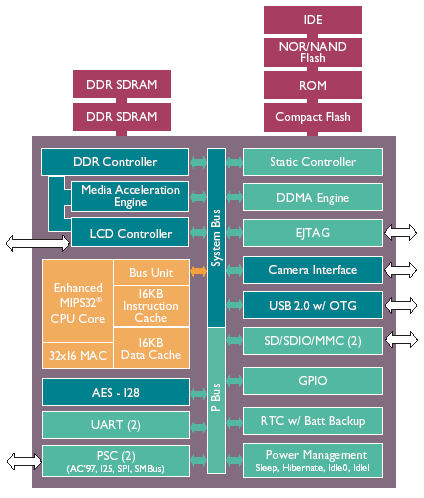AMD targets high-integration MIPS SoC at PMPs
Jan 3, 2005 — by Henry Kingman — from the LinuxDevices Archive — viewsAMD is sampling a highly integrated MIPS32-based SoC (system-on-chip) targeting portable media players (PMPs) capable of displaying content from PCs and PVRs (personal video recorders). The Alchemy Au1200 supports embedded Linux, and comes with media player software that exploits low-level hardware acceleration for multiple media formats.
According to AMD, the Alchemy Au1200 can be used to build devices that download and display content directly from PCs and from PVRs, without the time-consuming need to “transcode” the content, or convert it to any particular format. This is possible, AMD says, because the Au1200 features hardware acceleration for MPEG, DivX, H.263, and WMV9, along with an integrated graphics controller support supporting “full D1 resolution.”
The Au1200 also features sophisticated power management capabilities, and saves power by eliminating the need for PMPs to be built with DSP (digital signal processor) co-processors, according to AMD.
The Au1200 will be produced in 333, 400, and 500MHz varieties, with the 333MHz model expected in Q2, 2005. The chip features a MIPS32 core with 16KB each of instruction and data cache, along with a truly suprising number of on-chip peripheral interfaces. Integrated peripherals include IDE, dual-UARTs, USB 2.0, GPIO, an SDIO/MMC card interface, AC'97 audio, and more.

The Au1200 boasts a built-in sophisticated graphics controller and a plethora of peripheral interfaces
AMD says the integrated graphics controller supports frame rates of 30 fps at 720 x 480 resolution. Additionally, it can scale WMV9 and MPEG-1, -2, and -4 files up to 1024 x 768 resolutions. Scalable, DVD-quality graphics enables the chip to be used in media adapters or in PMPs that support external video displays, the company says. The graphics controller supports up to four prioritized over-lays, which AMD says simplifies user interface programming.
AMD lists key features of the Au1200 as follows:
- Low-power, high-performance processor with long-term support
- Power consumption of less than 400mW @ 400MHz
- DVD video quality (720×480) with multiple video formats
- Scales to larger displays (1024×768)
- Support for DDR1 and DDR2 memories
- Integrated Media Acceleration Engine
- No need for external DSP — simpler programming environment and fewer components
- Multimedia transcoding is not required
- USB2.0 Host and Device
- Enables faster download and flexible connectivity
- LCD controller with overlays and blending capability
- Camera interface and Internet access peripherals
- Security
- AES-128 data encryption/decryption in hardware
- Operating system support
- Linux
- Windows CE
An August report from market research firm InStat/MDR projected 700 percent growth in the PMP market in 2004, along with 180 compount annual growth through 2008.
Iain Morris, a senior VP with AMD's personal connectivity solutions group, said, “The natural progression to the next 'must have' portable entertainment device is a video equivalent to the MP3 player.”
According to AMD, devices based on the Au1200 will be able to download content directly from Series2 TiVo DVRs (digital video recorders), thanks to support for the TiVo-To-Go initiative.
David Sandford, director of technology and licensing at TiVo, said, “TiVo-To-Go enables the secure transfer of broadcast content from a TiVo box to a personal media player, and allows consumers to enjoy their TV shows anywhere.”
Availability
The AMD Alchemy Au1200 processor will ship in production quantities in Q2, 2005, AMD says. The 333MHz will sell for $22.50 in 10K quantities.
A portable media player and content management software stack that supports the Au1200 running either embedded Linux or Windows CE is available from Implicit Networks. Implicit will also offer software for managing PMP content remotely from PCs and laptops running Linux, OS X, and Windows.
A Linux-based portable media player reference design for the Au1200 (which incorporates the Implicit PMP software stack) will be available separately from FIC, a major Taiwanese motherboard vendor.
Further details on the Au1200 are here.
This article was originally published on LinuxDevices.com and has been donated to the open source community by QuinStreet Inc. Please visit LinuxToday.com for up-to-date news and articles about Linux and open source.